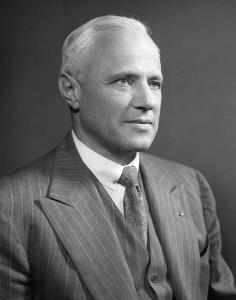 Karl Taylor Compton (September 14, 1887 – June 22, 1954) was a prominent American physicist and president of the Massachusetts Institute of Technology (MIT) from 1930 to 1948. In 1908 he graduated from Wooster University cum laude with a bachelor of philosophy degree, then in 1909 his master's thesis A study of the Wehnelt electrolytic interrupter was published in Physical Review. During (1909–1910) he was an instructor in Wooster's chemistry department before entering a graduate program at Princeton University. There he received the Porter Ogden Jacobus Fellowship, and worked with Owen Willans Richardson and jointly published several papers on electrons released by ultraviolet light, electron theory and on the photoelectric effect. Richardson went on to receive the Nobel Prize in some of the areas where Compton contributed. In 1912 Compton received his Ph.D. from Princeton summa cum laude.
Karl Taylor Compton (September 14, 1887 – June 22, 1954) was a prominent American physicist and president of the Massachusetts Institute of Technology (MIT) from 1930 to 1948. In 1908 he graduated from Wooster University cum laude with a bachelor of philosophy degree, then in 1909 his master's thesis A study of the Wehnelt electrolytic interrupter was published in Physical Review. During (1909–1910) he was an instructor in Wooster's chemistry department before entering a graduate program at Princeton University. There he received the Porter Ogden Jacobus Fellowship, and worked with Owen Willans Richardson and jointly published several papers on electrons released by ultraviolet light, electron theory and on the photoelectric effect. Richardson went on to receive the Nobel Prize in some of the areas where Compton contributed. In 1912 Compton received his Ph.D. from Princeton summa cum laude.
After the Armistice of 1918, the end of World War I Compton returned home to Princeton, his wife and three year old daughter Mary Evelyn. In June 1919 Compton was made a full professor, and worked in the Palmer Laboratory where his gift for teaching was legendary. His research was in the area of electronics and spectroscopy in subject areas such as passage of photoelectrons through metals, ionization, the motion of electrons in gases, fluorescence, theory of the electric arc, absorption and emission spectra of mercury vapor, and collisions of electrons and atoms. Unfortunately, Rowena died in the fall of 1919. In 1921 Compton married Margaret Hutchinson, with whom he had a daughter, Jean, and a son, Charles Arthur. In 1927 Compton was named Director of Research at the Palmer Laboratory and Cyrus Fogg Brackett professor. In 1929 he was appointed head of the department. Over one hundred papers were published in his name during his time at Princeton.
In 1923 Compton was elected a member of the American Philosophical Society and in 1924 a member of the National Academy of Sciences for which he was chairman of the Section of Physics (1927–1930). He was named vice-president of the American Physical Society (APS) in 1925 and in 1927 became its president. Compton was also a fellow of the Optical Society of America, a member of the American Chemical Society, the Franklin Institute and other professional engineering societies.
In 1930 Compton accepted an invitation from the MIT Corporation to be president of the Massachusetts Institute of Technology (MIT), an engineering school that was redefining the relationship between engineering and science. He took office at the beginning of the Great Depression in America, a time of economic turmoil and a time when science was under attack as a source of social ills and national despair. Compton was to strengthen basic scientific research at the Institute while becoming a spokesman for science and technology.
During Compton's service as President the organization went through a revolutionary change. He developed a new approach to education in science and engineering, the influence of which was felt far beyond MIT. Significantly, he was active in the Society for the Promotion of Engineering Education, and its president in 1938. He was a leader in establishing new standards for the accreditation of engineering criteria through his role as chairman of the Committee on Engineering Schools of the Engineer's Council for Professional Development. He believed in broad-based education for scientists and engineers that was responsive to the needs of the time, and that science should be an element of industrial progress.
In 1933 U.S. President Roosevelt asked Compton to chair a new Scientific Advisory Board that lasted two years. This put him into a forefront of scientists that perceived a need for reliable scientific advice at the highest levels of government. The start of World War II motivated the start of the National Defense Research Committee (NDRC), created in 1940 under the chairmanship of Vannevar Bush. Compton was a member of the NDRC and became head of Division D which was responsible for assembling a group of academic and industrial engineers and scientists that would study primarily RADAR, fire control and thermal radiation. In 1941 the NDRC was assimilated into the Office of Scientific Research and Development (OSRD) where Compton chaired the United States Radar Mission to the United Kingdom. In 1945, Compton was selected as one of eight members of the Interim Committee appointed to advise President Harry S. Truman on the use of the atomic bomb. When Japan surrendered in 1945, World War II came to an end and Compton left the OSRD. In 1946 Compton chaired the President's Advisory Commission on Military Training. From 1946 to 1948 he was a member of the Naval Research Advisory Committee. Compton chaired the Joint Research and Development Board from 1948 to 1949, when he stepped down for health reasons.